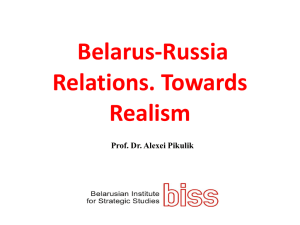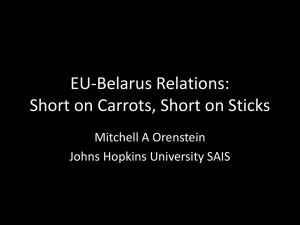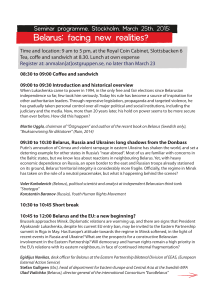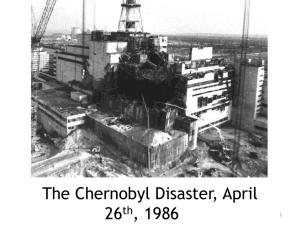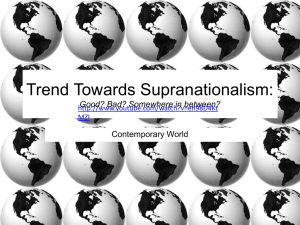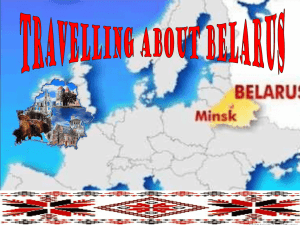BELARUS´ ECONOMY: SURVIVAL OR DEVELOPMENT
advertisement
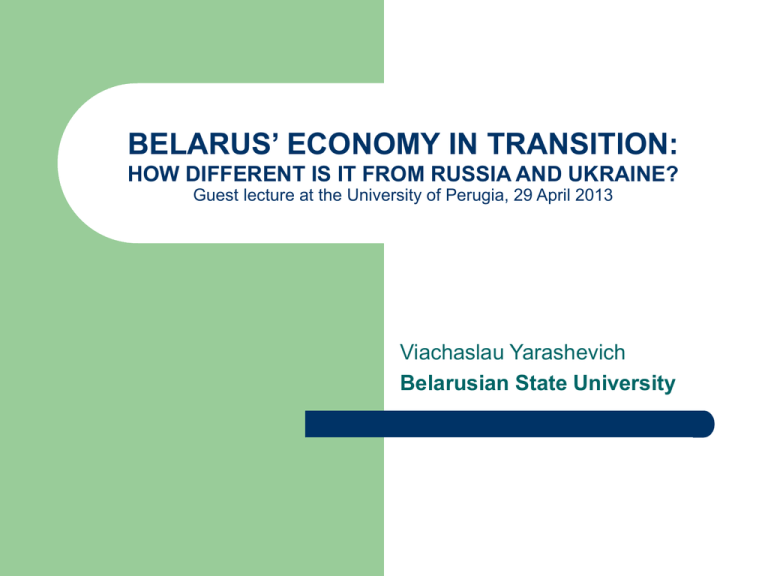
BELARUS’ ECONOMY IN TRANSITION: HOW DIFFERENT IS IT FROM RUSSIA AND UKRAINE? Guest lecture at the University of Perugia, 29 April 2013 Viachaslau Yarashevich Belarusian State University TRANSITION OR TRANSFORMATION? In the academic literature “transition” usually refers to reforms that started in Eastern Europe and former Soviet Union in the early 1990s It is commonplace to distinguish between “shock therapy” and gradual modes of transition, but it seems more justified to juxtapose neo-liberal and social-democratic models of reforms in the region Whether it is “transition” at all is still not clear, as most postcommunist countries developed their own peculiar political economies that often differ from Western ones – so maybe it is “transformation”? WHY BELARUS IS IMPORTANT? A relatively small economy of 9.5 million people and 60 bn USD GDP (2012), located in the geographical heart of Europe, it has rejected neoliberalism and “shock therapy” Before the global economic crisis this looked odd, but not anymore – the world in general and eurozone in particular are increasingly deviating from mainstream neoliberalism Despite its unusual policies, Belarus performs better than its former USSR peers, including Russia and Ukraine, on many economic and social indicators Some background to Belarus’ economic history prior to 1991 Before the Revolution of 1917 Belarus’ economy was virtually non-existent – 97% of people lived in rural areas and only less than 1% worked in industry, mostly small and medium enterprises Between the wars limited investment was carried out both in the eastern and western parts of the divided nation (my hometown of Maladzechna as an example) But it was not until after the WWII that Belarus’ economy was created, literally from scratch, as the Germans destroyed not just two thirds of the population, but four fifths of the physical infrastructure (see Vakar 1956) Some background to Belarus’ economic history prior to 1991 (cont.) The bulk of investment was made in the 1960s and 1970s – it was also the time when Belarus urbanized (in the early 1950s nearly 80% lived in the countryside, whereas in the late 1980s two thirds lived in the cities) Within USSR’s economic system/ division of labor Belarus specialized in high-value-added manufacturing: machine-building, chemical industry, military equipment (Ioffe 2004) Indeed, by late 1980s Belarus’ economy was clearly based on two industrial pillars, complementing each other: machine-building and chemical sectors (Shevtsov 2006) In 1991... Belarus was the fourth most advanced republic of the USSR after the Baltics, with Human Development Index of 0.8, enough to put it in the top development category by UN standards) Belarus was also one the most industrialized economies in the world despite virtual lack of natural resources, with nearly a third of its workingage population working in industry (World Bank 1997) In 1991... (cont.) ‘When Belarus became independent in 1991, it was the richest of the twelve republics of the Commonwealth of Independent States (CIS) in terms of per capita income, a status reflecting the republic’s steady growth during the 1970s and early 1980s’ (World Bank 1997) ‘Belarus’ industry was the most technologically advanced in the entire Soviet Union. The worn-out phrase that Belarus was an assembly workshop of the USSR was not exactly accurate. Belarus’ specialisation was on R&D and assembling high-tech products. The important feature was that almost all the personnel for R&D were trained within Belarus…’ (Ioffe 2004) Economic developments in the early 1990s 20 Industrial output 15 10 5 Agricultural output 0 Per cent change -5 -10 1970 1972 1974 1976 1978 1980 1982 1984 1986 1988 1990 1992 1994 Capital investment -15 -20 -25 Household incomes -30 -35 Retail turnover -40 -45 -50 New homes built Economic developments in the early 1990s From 1991 to 1995 Belarus’ GDP fell by a third; real wages – by almost a half; and investment – by 60% Hyperinflation wiped out dozens of billions of savings Prices doubled every month (at ~2000% annual rate) Wages hovered around 20$ a month Unemployment, non-existent in the Soviet era, reached nearly 3% by official counts, unofficially it was several times higher Lukashenka phenomenon Belarus’ economy as it looks today is due largely to policies of the country’s first (still) president Aliaksandr Lukashenka who was elected in 1994 Born and grown-up in the countryside, this man followed his intuition for the most part of his political career and sought his support mostly from the grassroots, rejecting neoliberalism and liberalism in general Lukashenka’s economic agenda Price stabilization State control of economy Investment resumption State support of agriculture and industry Active social policy (‘Otvesti narod ot propasti’ [To turn away people from abyss], Narodnaya Gazeta, 14 June 1994) Lukashenka’s economic agenda ‘…[Lukashenka’s] rule is a logical outcome of the population’s entrenched Soviet mentality and widespread nostalgia for the relative prosperity and stability of the old system’ (Mihalisko 1997) ‘Lukashenka stopped voucher privatisation… and secured subsidised transport and utilities and free health care and education. By that time (1995), most industrial workers worked barely 2-3 days a week...but they could perhaps eke out a living for a year or so at the most with the aid of their own kitchen gardens. In about a year (by 1996) most industrial giants had resumed their full capacity work schedule, mostly due to the restored ties with Russia. That was what Lukashenka had been voted for in 1994, and that was what he made good on’ (Ioffe 2004) THE TRANSITION In postcommunist countries, transition meant foremost liberalization, privatization and restructuring aimed at reducing the role of the state and fostering private enterprise Belarus, Russia and Ukraine were no exception – all three embarked on transition path in 1991, but five years later Belarus deviated LIBERALIZATION Liberalization has been the cornerstone of postcommunist reforms For neoliberals, it meant foremost liberalization of internal pricing, as well as of foreign trade and currency exchange On all these accounts, Belarus, Ukraine and Russia started with similiar vigour, but Belarus slowed down and even reversed the process in the mid-1990s LIBERALIZATION (cont.) 4.5 4 3.5 3 Belarus 2.5 Russia 2 Ukraine 1.5 1 0.5 0 1991 1996 2001 2006 2010 PRIVATIZATION Privatization was perhaps the single most important reform which determined the whole course of transition While laws on privatization were adopted in all three countries at about the same time, their implementation was different In Belarus privatisation was very sluggish yet under Kebich administration (1991-4), and was virtually stopped by president Lukashenka (1995-?) In Russia and Ukraine, by contrast, privatisation became a very loud affair, with its own national heroes and anti-heroes (e.g. Boris Berezovskiy, Mikhail Khodorkovskiy, or Roman Abramovich – treat them as you like) PRIVATIZATION (cont.) 4 3.5 3 2.5 Belarus 2 Russia Ukraine 1.5 1 0.5 0 1991 1996 2001 2006 2010 PRIVATIZATION (concl.) It seems that progress with privatization in Russia and Ukraine led to more reform dynamism there. Notably, private owners of privatized and brand new private companies demanded rapid liberalization of price regulation, tax cuts, less administrative regulation, free trade regimes and other measures associated with market reforms. Labour laws were relaxed, private companies allowed to bid for public projects, and in Russia even the pension system was reformed according to Western neo-liberal recommendations As there was no mass privatization in Belarus, so there was no significant internal pressure to liberalize the economy RESTRUCTURING In transition economies, restructuring meant discipline and encouragement Discipline the state sector, so that it goes bankrupt and releases capital and labour to encourage the nascent private sector Easy in theory, in practice progress was far less impressive than with privatization RESTRUCTURING (cont.) 2.5 2 1.5 Belarus Russia 1 Ukraine 0.5 0 1991 1996 2001 2006 2010 SO? Overall GDP performance in Belarus has been better than in Russia or Ukraine despite less progress with transition 200 180 160 140 1995 120 2000 100 2005 80 2010 60 40 20 0 Belarus Russia Ukraine In per capita terms… Russia has been the richest among the three Slavic countries throughout the transition, which may be justified by its rich natural resource endowment But Ukraine’s lagging behind Belarus is odd Year 1991 1996 2001 Belarus 1747 1452 1239 Russia 3427 2651 2101 Ukraine 1490 873 781 RU>BY 2.0 1.8 1.7 BY>UA 1.2 1.7 1.6 2006 2011 3798 5715 6947 12890 2303 3697 1.8 2.3 1.6 1.5 What about wages and pensions? GDP is certainly a favourite indicator for economists, but for the rest relative economic success is measured in terms of incomes here Belarus again lags behind Russia but is ahead of Ukraine (top – monthly wages in USD, bottom – pensions Year 1995 2000 Belarus 66 89 Russia 104 79 Ukraine 50 43 2005 2010 215 409 303 688 157 281 1995 34 53 26 2000 46 29 16 2005 98 90 79 2009 153 195 128 INEQUALITY But of course GDP and income levels matter little if their distribution is unequal – it is important both for social justice and labour incentives As a rule, developing countries are more unequal than developed ones, and among the latter Nordic countries are both economically more successful and more equal than others Among the three Slavic countries Belarus has been the most equal one throughout the transition as measured by Gini (0 – absolute equality, 1 – absolute inequality) INEQUALITY (cont.) 0.5 0.45 0.4 0.35 0.3 0.25 0.2 0.15 0.1 0.05 0 Belarus Russia Ukraine 1995 2000 2005 2009 EDUCATION AND HEALTH CARE Belarus has consistently ranked higher in UN Human Development Index which takes into account education and health status This was due to both higher spending levels and better management (on average 4-6% of GDP compared to 3% for Russia and Ukraine) As a result, Belarus has had higher enrolment ratios at all levels of education (including pre-primary) and lower incidence rates for major diseases So can one call Belarus a postcommunist welfare state? Belarus has the lowest income inequality (~0.25 GINI), infant mortality (less than 5 per thsd) and poverty (~6%) in the former USSR It also has the lowest unemployment, highest enrolment and lowest disease levels in the region Belarus has not increased retirement age (55 for women and 60 for men), and also has flat income tax of 12% CONCLUSIONS The comparative analysis of post-communist socioeconomic development in Belarus, Russia and Ukraine leads to a number of conclusions, key among which is the fact that Belarus has outperformed Russia and Ukraine on many counts despite lack of reforms Critics would say that Belarus’ socio-economic achievements are only due to lasting discounts on natural gas and oil sold by Russia But although the scale of Russia’s economic aid to Belarus is indeed significant, viewing it as an opportunity cost or Russia’s lost profit is not without blemish CONCLUSIONS (cont.) Surely Russia has not acted out of goodness of heart towards Belarus Belarus is Russia’s only full-fledged ally. There are no customs on their border, there are two Russian military bases in Belarus, for which Russia pays no fees, scores of Belarusian military personnel study in Russian schools, and all of the Belarusian army’s ammunition is either Russian made or a product of Russia-Belarus industrial cooperation Finally, by contrast to Ukraine Belarus has never irritated Russia with NATO or EU aspirations, instead being consistently committed to the Union State between two countries, the CIS, as well as the Customs Union and Single Economic Space CONCLUSIONS (final) Belarus’ transition (or transformation) has clearly been different from that of Russia’s and Ukraine’s Instead of following neoliberalism as both Russia and Ukraine did, Belarus opted for its own welfare state model Instead of seeking closer links with the West, Belarus integrated eastwards, thus preserving its traditional markets for resource imports and manufactured exports Perhaps Belarus’ experience may be useful for other postcommunist countries (and beyond) in tackling the global economic crisis?


